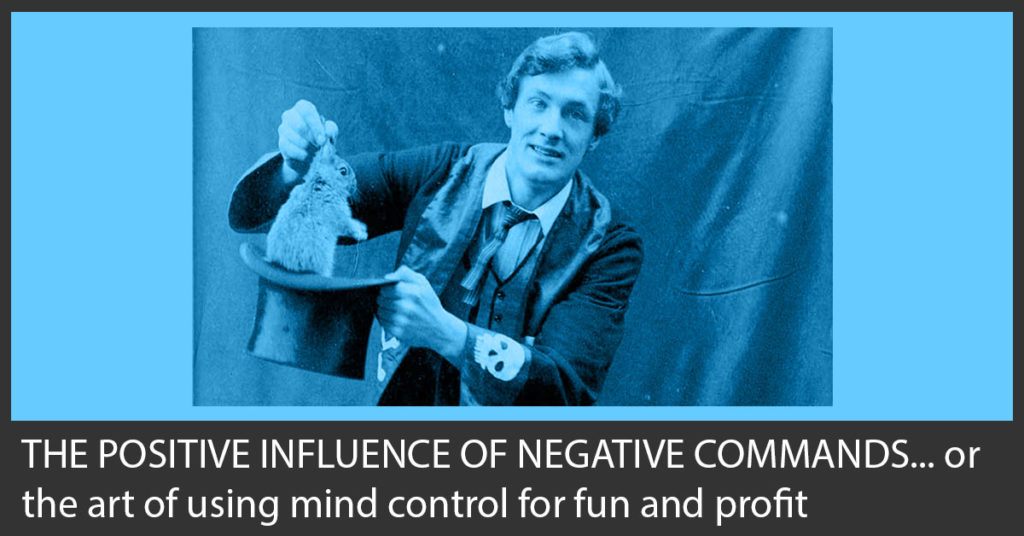
Promise me you won’t use this for evil… OK?
In their classic writing book, The Elements of Style, Strunk & White recommend you avoid using negative phrases whenever possible—especially, those containing the word, “Not.”
For example, instead of writing a negative phrase such as, “Simon is not honest,” you should change it into a positive one by rewriting it as, “Simon is dishonest.”
In other words, it’s better to tell what Simon “is” rather than what Simon “is not.”
The word, “Don’t,” is a contraction of the phrase, “Do not,” and should therefore be avoided as well.
HOWEVER…
In the world of online sales (or, even more diabolical forms of mind manipulation), using these “negatives” is a sneaky way of influencing someone to do what you want.
WARNING: Do NOT read past this line unless you want to uncover secrets far too shocking for the average human mind to withstand.
You’re still here, right? Even after the full-blown warning above.
In fact, you probably want to read this section EVEN MORE than if I hadn’t issued the warning at all.
So, what type of witchcraft is going on here?
Some will recognize this as a classic NLP sales trick. For example, if you want someone to buy your eBook, you could say:
If making millions overnight isn’t important to you, then DON’T BUY THIS EBOOK!
The phrase, “DON’T BUY THIS EBOOK!” is a special kind of phrase. It’s what a lot of NLP gurus, hypnotists and con-artists call a “negative command.”
The phrase actually inspires those who read it (or hear it) to take a positive action on the negative command; in this case, they would be more inclined to “buy” the eBook than they would be if you didn’t use the phrase at all.
There are several things at work here.
The first is that the human brain does not visualize a state of “don’t.”
Go ahead; try to visualize yourself in a state of “don’t.” You can’t do it!
You might visualize yourself in an empty room sitting in a chair doing nothing, but you’re still visualizing a “positive action” in which you are in a state of “doing” nothing.
You can visualize yourself “buying” an eBook, but you can’t visualize yourself “not buying” an eBook.
You could see in your mind a picture of yourself buying an eBook and then visualizing a big red circle with a line through it superimposed over that image, but you can’t visualize that without first visualizing yourself in a positive state of buying the eBook!
The second thing that happens with phrases like this is that human beings are naturally resistant to commands anyway. People don’t like to be told what to do.
So, if you say, “Buy my eBook,” the natural human impulse is to resist by saying, “No.”
That’s because saying, “No,” is the safest choice. It takes away the commitment and allows time to evaluate the consequences before considering a “Yes.”
Another thing to recognize is by agreeing with your command they are, in essence, giving you a degree of power over them. You are telling them what to do and they are obeying.
This produces a naturally uncomfortable psychological situation which also adds to the resistance.
But, what if you say, “DON’T buy my eBook”?
This starts to mess with their mind a little bit, doesn’t it?
Now, the only way to “not buy your eBook” is to agree with your command thus giving you a degree of power over them and by saying, “Yes,” which opposes the natural human impulse. Nasty!
For fun, let’s dissect the following headline:
Don’t buy this eBook Unless You Want to Get Rich!
First, let’s remove the words and phrases that carry zero visual impact.
Don’t Buy this eBook Unless You Want to Get Rich!
So, now… logically, what are the ONLY two visual conclusions the reader could possibly come up with from that headline which may-or-may-not influence their next course of action?
Buy this eBook. You. Get Rich!
Ahem…
Look, I’m not saying the use of dastardly NLP tactics like this will have a major impact on your sales, but I’m not NOT saying it either.
Just remember this: the next time you hand someone a delicate vase and say, “Now, don’t drop it!” you are in essence increasing your chances of cleaning up broken glass.
By the way, my latest product, Easy eBook Outline, is getting rave reviews, but don’t buy it unless you want to learn my easy, step-by-step method for cranking out dozens of high quality eBooks that sell like hotcakes.
Here’s the link: Easy eBook Outline: How to turn your scrambled thoughts into finished products
Muahahahah…
